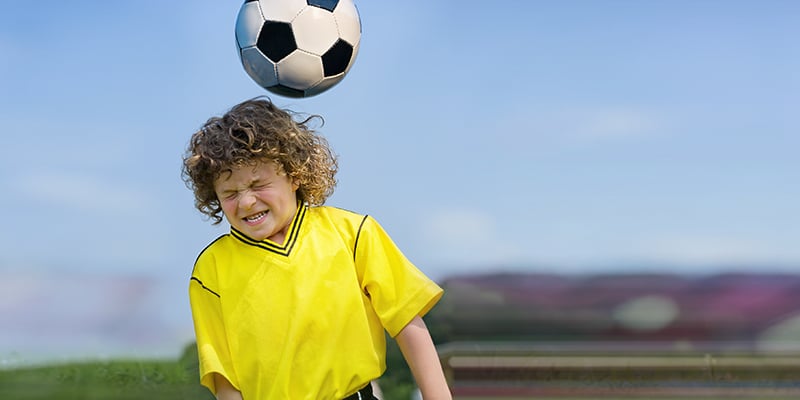
Many people associate sports concussions with football since it is widely publicized in the media. However, we tend to forget about the popular sport soccer, where frequent contact with the ball and head occur since players use their heads to propel the ball to score, at it is recognized as a skill in the game.
A study showed that players who headed an average of 125 balls over the course of two weeks were more prone to concussions than those who headed only four balls in that same period of time. Those players who headed more frequently were more prone to complain of concussion symptoms like unconsciousness, dizziness, headaches, and confusion.
One Sport, Multiple Risks
But heading is not the only way that soccer players can get a brain injury. There is also a lot of player to player contact that has not been accounted for on the field. For example, one study shows that player contact was to blame for 69 percent of concussions in boys and 51 percent of girls. While no sport is necessarily “safe” specialists believe that the takeaway is to enforce fair play and the rules of the game rather than put on a show for spectators.
The problem with the show aspect of the sport is that many times children try to emulate what they see on TV leading to aggressive behavior on the field. John O’Kane, a sports physician, and professor at the University of Washington Medical Center thinks that banning heading might not solve the whole problem. “Heading is part of the sport and while there is risk involved, no sport is completely safe,” he says via email. “The question is how to make heading and soccer in general safer, especially for kids. I believe that we place an emphasis on winning over learning proper technique at too young an age,” he says, “The result is teams with big, fast aggressive players that win by running over people instead of playing good soccer.”
It is important to note that your child is always vulnerable to head injuries in sports. Discuss ways to avoid concussions when they aren’t necessary, like heading and aggressive play in soccer.
Unfortunately, sometime these can’t be avoided. Be prepared and follow our checklist below.
8 Ways to Recover From a Brain Injury:
1. Protect Your Brain
You do not want to retain any more damage if you’ve already suffered head trauma. You should protect your brain from further injury as best you can.
2. Have Brain Envy
As you move forward with a brain healthy life, it’s important to keep your brain health at the forefront of your daily actions and behaviors. Brain Envy is a term we use to describe the burning desire to have a better brain.
3. Avoid Things That Can Damage The Health Of Your Brain
Some examples include being overweight and toxic substances like alcohol.
4. Give Your Brain A Healthy Foundation With Brain-Directed Dietary Supplements
Some essential to start with include a great multiple vitamin and mineral to assure a broad spectrum of nutrients, and a higher-serving fish oil (3-4 grams for adults, 1-2 grams for children) to support a healthy response to inflammation, healthy levels of DHA in the brain, and healthy nerve cell fluidity.
5. Move Your Body!
Exercise boosts brain blood flow and improves mood, instantly! If exercise is new for you, start with “walking like you’re late” for 45 minutes, 4 days a week.
6. Eat Right So You Can Think Right
7. Get At Least 7-8 Hours Of Sleep Each Night
8. Consider Natural, Brain Healthy Treatments That Promote Healing
Depending on the severity, consider hyperbaric oxygen therapy (HBOT), and biofeedback or neurofeedback. These are great ways to support optimized brain function.
At Amen Clinics, we look for the least harmful, most effective way of healing the brain, which typically means treating patients naturally (supplements, nutrition, lifestyle recommendations) rather than with high-powered psychiatric medications.
Our Full Evaluation of your biological/psychological/social/spiritual history, coupled with two brain SPECT imaging scans (in concentrating and resting states), cognitive testing, and clinical assessment is designed to address unique needs and offer targeted treatment options.
If you would like to learn more about how brain imaging can provide customized solutions for you or a family member, call us today at 888-288-9834 or visit us online to schedule a visit.





Do you do any work on cluster headaches?
Comment by Kathleen — September 10, 2018 @ 5:20 AM
Hello Kathleen, yes we do work with patients to address headaches and migraines. We have services beyond brain SPECT scans to help with this as well, one is Microcurrent Therapy: https://amenclinics.com/treatments/microcurrent-therapy/.
Comment by Amen Clinics — September 10, 2018 @ 7:48 AM
What causes brain “zaps”?
Comment by Linda — September 12, 2018 @ 2:57 AM
How can we protect our child with these type of diseases ?
Comment by David James — May 21, 2019 @ 11:43 PM